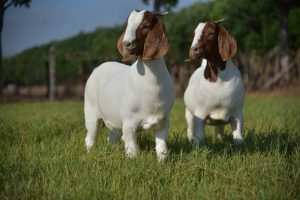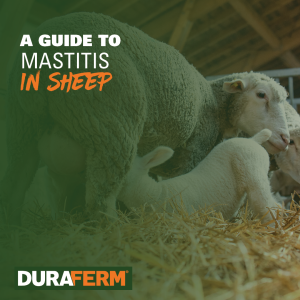
Goat Breeding
At BioZyme, we know that reproduction is the key to profitability. If your livestock are not reproductively sound, your bucks will not breed or make semen, and your does will not breed. Several factors lead to successful goat breeding, and we want to be sure you are ready.
Although we are not reproductive experts, we offer this guide with some practical advice to prepare you for the breeding season.
Prepare the Buck for Breeding
Often times we solely focus on the females in the herd when we discuss preparing for breeding season. Don’t worry. We will get to them later in the blog. But the bucks also contribute 50% of their genetics to future offspring, and they are often overlooked.
Breeding Soundness Exams are Vital
At least one month to six weeks before you plan to turn out your bucks, we advise you conduct a breeding soundness exam (BSE). This window of time will allow you to retest any buck that has questionable semen production or replace a buck that fails the BSE before breeding season begins.
A veterinarian or other reproductive expert should be able to conduct the BSE. That is just another reason why the veterinarian-client relationship is so important.
What is a BSE?
The BSE evaluates two important components of your buck battery.
First, it will evaluate the structural soundness. Your bucks must be sound on their feet and legs so they can physically walk to the does. They must have healthy feet and hooves. And they must be able to stand and mount the does during breeding. For the aforementioned reasons, structural soundness is critical to the BSE.
The second part of the BSE is a semen check. The veterinarian will check the scrotal health of your buck and collect a semen sample to evaluate. This is also a good time to tell the veterinarian if the buck has experienced a fever or any sickness, as both of these can have an impact on buck fertility.
Once your buck passes his BSE, he is ready to go to work. You will want to keep bucks separated from does until it is time to turn out. Make sure he maintains a healthy diet to be in ideal body condition. Finally, be sure to trim any feet that might be in rough shape. A ram with long or rough hooves will not be able to walk or mount the does properly.
Trim about 2 to 3 weeks prior to turnout to give the hooves enough time to heal.
Deworm
Parasite control should always be top-of-mind when preparing for goat breeding, especially in the summer months. Deworm your buck battery before turning out to ensure your buck stays healthy and worm-free.
Getting the Does Ready for Breeding
Although goat breeding relies on the male getting the doe bred, the female is responsible for carrying those babies and delivering and raising the kids.
That’s why preparing a doe for goat breeding is crucial. Otherwise, you may struggle with unreliable reproduction rates or, worse, unhealthy offspring. Ensuring the doe is free from any health issues or parasites can significantly improve breeding outcomes. That also leads to better overall herd health.
That’s where proper nutrition, health and wellness monitoring and quality of life come into play. If you want quality outcomes, keeping does healthy and happy is essential to optimize fertility and support a developing fetus.
But, what does that care look like?
Animal Grouping
Goats are very social animals. It is best to pen them by potential sire group a few weeks before turning the buck in with them so they can establish a pecking order. If you wait to sort and pen at breeding, their pecking order could be disrupted. This could ultimately negatively influence their reproductive performance.
Animal Health Matters
Many producers will vaccinate their herd only before kidding season. However, if you are the type of producer who likes to work proactively, you can add a second round of vaccinations. Those should be administered just prior to goat breeding.
If you do choose to vaccinate, overeating disease (enterotoxemia) and tetanus are the two things recommended to vaccinate for. Vaccinate just prior to breeding for best results.
You should also deworm your does, as worms can wreak havoc on body condition score and the ability to breed and maintain pregnancy.
Foot Trimming
Just like the bucks, make sure your does have their hooves trimmed. As gestation progresses, they will be carrying extra weight, and you want to ensure they have a good set of wheels under them to carry that weight. Additionally, trimming hooves prior to breeding will not disturb the pregnancies.
Detection of Estrus
Monitor the estrus or heat cycle of your does to determine the optimal time for breeding. Look for signs of estrus, such as restlessness, tail flagging, mounting behavior, vocalization and mucous discharge. Use estrus detection aids, such as teaser bucks or marking harnesses, to identify does in heat accurately.
Determine Breeding Method
With modern reproductive technologies, producers have opportunities outside of traditional breeding with a buck. You might decide that artificial insemination (A.I.) or embryo transfer (E.T.) is better suited for your operation. Perhaps, you want to use a combination of technologies, if you have a really good donor doe for E.T. purposes, a few good does to A.I.
Then, you can follow up your A.I. with a buck and naturally breed any other does that you don’t want to breed using advanced techniques.
The Role of Body Condition Score
Body Condition Score of both your does and bucks is important as you prepare for goat breeding season. BCS in goats range from 1 to 5, with 1 being way too thin, and 5 is overly conditioned or obese. A good body condition score for does and bucks going into breeding season is 2.5 to 4.
BCS in goats is best assigned by both visual appraisal and handling your goats in three areas. First, you will want to evaluate the lumbar area, which is the area of the back behind the ribs containing the loin. Next, you will want to assess the fat covering on the sternum (breastbone). Finally, you should feel the fat cover on the rib cage and between the ribs.
A doe, especially one with a low BCS, will have a challenging time getting and staying bred. Females that are underconditioned and malnourished greatly inhibit reproductive success. As nutrition is partitioned, reproductive needs are the first sacrificed. The doe will first use nutrients for growth and her own energy before she uses them for reproduction.
Both does and bucks with high BCS scores will also have breeding challenges. Excessive body condition makes it challenging for the doe to cycle.
The Gestation Cycle & More
The average gestation length (length of pregnancy) of a goat is 150 days or roughly five months. DuraFerm has created a Goat Gestation Calculator to make it simple for you to calculate the gestation length of your herd.
Most does will have 1 to 2 kids during their initial birthing season. Subsequent seasons does could have triplets and even quadruplets, although twins are most common.
Nutritional Considerations
One of the most important aspects of getting your herd ready for breeding season is to provide both the does and bucks with the most complete diets possible. This includes a balance of vitamins, minerals, water, protein, energy and forages.
DuraFerm Can Help
DuraFerm® is a line of nutritional supplements for sheep and goats that supports optimal digestion and nutrition for maximized performance at every stage of production. For goats, we offer two products designed to help strengthen your stock and support reproductive success.
DuraFerm® Goat Concept•Aid®
DuraFerm Goat Concept•Aid is a free-choice vitamin and mineral supplement for goats designed to support reproductive success. Goat Concept•Aid contains AO-Biotics® Amaferm®, a prebiotic research-proven to enhance digestibility. It also includes high levels of vitamin E for reproductive tract repair and supports embryo production and conception using organic trace minerals. It comes in a 50-pound bag.
DuraFerm® Goat Concept•Aid® Protein Tub
DuraFerm Goat Concept•Aid Protein Tub is a 50-pound protein tub with vitamins and minerals for goats designed to support reproductive success. This protein tubs also contains Amaferm, a prebiotic research-proven to enhance digestibility. It contains the Concept•Aid goat mineral package in a 20% natural protein tub and supports embryo production and conception using organic trace minerals and high levels of vitamin E.
Both products are recommended to be fed to the entire herd 30 days prior to kidding through at least 30 days post-breeding. They can be fed year-round to both does and bucks, and for increased protein at kidding, switch between the loose mineral to the tub.
Final Words of Advice
After reading this blog, we hope you are excited about your next set of kids – of the goat kind that is. Goat breeding has several considerations and things to remember, and we just scratched the surface on primarily overall health, nutrition and soundness.
Remember, this is one quick resource. We really want you to establish a relationship with your veterinarian. No matter if you have been raising goats for 10 years or 10 months, you will always have some issue arise that requires medical attention. Having a trusted relationship with your vet will help him or her help your herd.
Keeping both the does and bucks in good reproductive shape should lead to a favorable season of breeding. Goats tend to be social animals so make sure to give them plenty of attention during breeding and into kidding season.
Get your DuraFerm Today
Do you want to get your herd into tip-top shape with DuraFerm Goat Concept•Aid products powered by AO-Biotics Amaferm? You can! DuraFerm is available through the extensive BioZyme dealer network. Locate a dealer near you today.
Don’t forget to use our Goat Gestation Calculator. This handy guide will help you with all your goat breeding calculations.
You can also learn more about DuraFerm from our educational blog series or by signing up for our newsletter.

